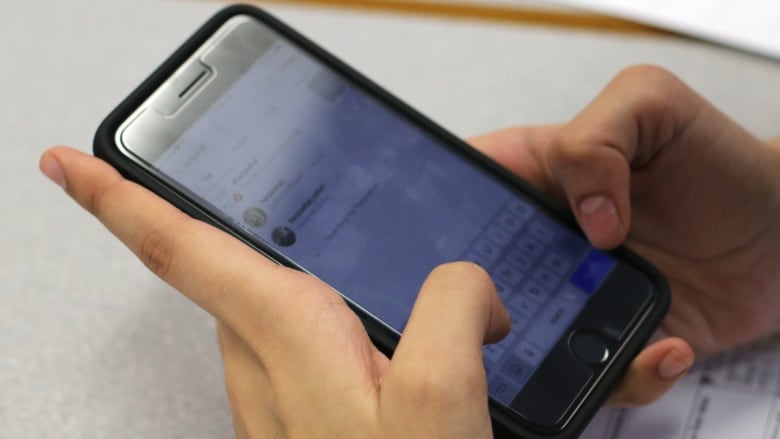One year after a cellphone ban, an N.B. high school principal is seeing results
Child and youth advocate says he'd work on district or department-wide bans if asked

In the age of cellphones, the devices have slowly made their way into classrooms across the world with sneaky texting under desks, headphones hidden under hair and even outright use during quiet moments in class.
Saint John High School principal Christina Barrington said around 10 years ago, there was even a push in educational circles to leverage the available technology and use it in the classroom.
"We became reticent to ban them because there were so many possible applications," she said.
"Then we tried to allow each individual teacher to make the rules in their classrooms. It made it very difficult for one teacher to be strict and another possibly to be more lenient. And we certainly saw more of them creeping into the downtime."

But Barrington took the leap around a year and a half ago and imposed a cellphone ban at the high school during instructional time.
She said the ban looks different from classroom to classroom. Some teachershave a "cell hotel," where students slot their phones into a numbered box, and others simplyask thatstudents keep their phones in their backpacks.
Either way, when a student comes into the classroom, headphones are to be removed and phones are put away.
Barrington said she's noticed a difference since the ban. She said teachers have reported fewer conflicts with students during teaching time because they aren't arguing with students to put their phones away.
Teachers are averaging around five to seven extra minutes of teaching time because of it, she said.
Classrooms are also louder,she said, but that isn't necessarily a bad thing in her eyes.
"When every student is allowed to escape, even temporarily to their phone, it leads to less conversation," said Barrington.
"From a social emotional perspective, we know that that leads to actually lower empathy. So when you don't have that like, sort of small talk downtime and get to know different people, you lack the ability to get to know different people, and sometimes your circle becomes smaller and smaller."
Barrington's inspiration for the ban came from a keynote she attended where one of the speakers, Dr. Michael Rich, talked about cell phones in schools.
Rich, the director of the digital wellness lab at the Boston Children's Hospital, said in an interview with CBC News that there is more known about the immediate mental health responses from using devices than there is about how it is affecting brain development.
He said it will be another 20 years before researcherswill know the impact of a five-year-old brain usinga tablet or cellphone.
But he said it is known that young people are more likely to become anxious or depressed if they spend significant time gaming, on social media, watching pornography, or what he said is called "information bingeing" on Reddit, Quora or YouTube.

Although Rich has strong feelings on the effects of cellphones, he said using the word "addiction" when talking about youth and media is not accurate. He called the term a "lightning rod" and said clinically, the end goal with addiction is abstinence, but that isn't possible with media.
"We need it for school, for work, for interacting with others and for exploring the world, frankly."
He said cellphone use can sometimes be related to FOMO, or fear of missing out, but even more than that, fear of being left out if theydon'trespond quickly enough to their online peers.
Rich saidscience supports not having phones in schools for two reasons. One, he said, is that they distract from the task at hand learning. Two, is that school is a young person's opportunity to "be an individual, to make their own way in the world," he said.
"If a child has a smartphone in their pocket, their parent is always present, is always asking," he said.
"Many of them ask 'how didyou do on the quizor what's happening on the playground?' And that denies the child the opportunity to be an individual in that new environment."

Kelly Lamrock, the province's child and youth advocate, when speaking to reporters earlier in the week, saidit could be a good idea for schools to be places where the phone goes away and students can engage on a human level with others.
In almost every jurisdiction, Lamrock said child and youth advocates are noticing that while social media use increases, the number of youth struggling with mental health issues is also going up.
"I don't think the two are unconnected anymore."
Lamrock also said parents should monitor screen time and earlier awareness of social media misinformation should be taught in school.
He said if his office were asked to help the Education Department or a school district create a policy banning cellphones, he would be open to doing that.
Barrington said from what she's hearing from students, it seemsthat they like the cellphone ban during class time.
"Once they settle into the rule, like any other rule at school, it just becomes the norm," she said.
Although Barrington's perceived reception of the ban is anecdotal, she's hoping that the student wellness survey over the next couple of years will show less depression and anxiety among students and more connectedness.
She also said grades are increasing. One chemistry teacher, said Barrington, has analyzed the Grade 11 chemistrygrades before and after the rule came into effect, and reports an increase in the class's overall average.

With files from Information Morning Saint John













_(720p).jpg)


 OFFICIAL HD MUSIC VIDEO.jpg)
.jpg)



























































































